重组小鼠EFNB2蛋白
- 蛋白种属:小鼠
- 表达宿主:人胚胎肾细胞(HEK293)
- Unitprot ID:Q4FJM3
产品详情
-
产品名称
重组小鼠EFNB2蛋白
-
蛋白种属
小鼠
-
表达宿主
人胚胎肾细胞(HEK293)
-
Unitprot ID
-
蛋白序列
Met 1 - Ala 232
-
克隆构建
A DNA sequence encoding the mouse EFNB2 (NP_034241.2) extracellular domain (Met 1-Ala 232) was fused with a polyhistidine tag at the C-terminus.
-
蛋白纯度
> 95 % as determined by SDS-PAGE
-
蛋白活性
Measured by its ability to compete with mouse EFNB2-Fc for binding to immobilized mouse EPHB4 in a functional ELISA assay.
-
分子量
The secreted recombinant mouse EFNB2 comprises 215 amino acids and has a predicted molecular mass of 23.5 kDa. As a result of glycosylation, the apparent molecular mass of rmEFNB2 is approximately 30-40 kDa in SDS-PAGE under reducing conditions.
-
蛋白别名
EFNB2; MGC126228; HTKL; HTK-L; LERK-5; ELF-2; LERK5; NLERK-1; MGC126227; RP11-272L14.1; EPLG5; MGC126226; EPL5; EPHRIN-B2
-
蛋白全名
Ephrin-B2
-
蛋白描述
Cell surface transmembrane ligand for Eph receptors, a family of receptor tyrosine kinases which are crucial for migration, repulsion and adhesion during neuronal, vascular and epithelial development. Binds promiscuously Eph receptors residing on adjacent cells, leading to contact-dependent bidirectional signaling into neighboring cells. The signaling pathway downstream of the receptor is referred to as forward signaling while the signaling pathway downstream of the ephrin ligand is referred to as reverse signaling. Binds to receptor tyrosine kinase including EPHA4, EPHA3 and EPHB4. Together with EPHB4 plays a central role in heart morphogenesis and angiogenesis through regulation of cell adhesion and cell migration. EPHB4-mediated forward signaling controls cellular repulsion and segregation from EFNB2-expressing cells. May play a role in constraining the orientation of longitudinally projecting axons.
-
发货形式
Lyophilized from sterile PBS, pH 7.4
1. 5 % trehalose and mannitol are added as protectants before lyophilization.
2. Please contact us for any concerns or special requirements.
-
内毒素
< 1.0 EU per μg of the protein as determined by the LAL method
-
保存条件
Store it under sterile conditions at -20℃ to -80℃. It is recommended that the protein be aliquoted for optimal storage. Avoid repeated freeze-thaw cycles.
重组蛋白定制服务:
纽普生物(NovoPro)提供大肠杆菌、哺乳细胞、昆虫细胞和酵母细胞重组蛋白定制服务
声明:本公司出售产品只能用于科研目的,不得用于诊断或者治疗!


